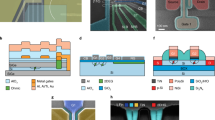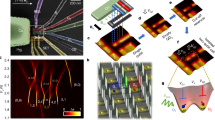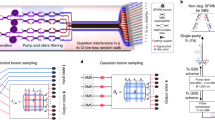Abstract
Quantum computers hold the promise of massive performance enhancements across a range of applications, from cryptography and databases to revolutionary scientific simulation tools. Such computers would make use of the same quantum mechanical phenomena that pose limitations on the continued shrinking of conventional information processing devices. Many of the key requirements for quantum computing differ markedly from those of conventional computers. However, silicon, which plays a central part in conventional information processing, has many properties that make it a superb platform around which to build a quantum computer.
This is a preview of subscription content, access via your institution
Access options
Subscribe to this journal
Receive 51 print issues and online access
$199.00 per year
only $3.90 per issue
Buy this article
- Purchase on Springer Link
- Instant access to full article PDF
Prices may be subject to local taxes which are calculated during checkout





Similar content being viewed by others
References
Lansbergen, G. P. et al. Gate-induced quantum-confinement transition of a single dopant atom in a silicon FinFET. Nature Phys. 4, 656–661 (2008).
Deutsch, D. Quantum theory, the Church–Turing principle and the universal quantum computer. Proc. R. Soc. Lond. A 400, 97–117 (1985).
Ladd, T. D. et al. Quantum computers. Nature 464, 45–53 (2010).
Hayashi, T., Fujisawa, T., Cheong, H. D., Jeong, Y. H. & Hirayama, Y. Coherent manipulation of electronic states in a double quantum dot. Phys. Rev. Lett. 91, 226804 (2003).
Tyryshkin, A. M. et al. Electron spin coherence exceeding seconds in high purity silicon. Nature Mater. (in the press); preprint at 〈http://arxiv.org/abs/1105.3772v1〉 (2011). This article reports the longest coherence time of any electron spin in the solid state; this was shown by donor electrons in silicon, with a T 2 of more than 10 s.
Steane, A. M. Efficient fault-tolerant quantum computing. Nature 399, 124–126 (1999).
Andreas, B. et al. Determination of the Avogadro constant by counting the atoms in a 28Si crystal. Phys. Rev. Lett. 106, 030801 (2011).
Feher, G. Electron spin resonance experiments on donors in silicon. Phys. Rev. 114, 1219–1244 (1959). This article reports on a seminal study that investigated a wide range of spin properties of donors in silicon.
Gordon, J. & Bowers, K. Microwave spin echoes from donor electrons in silicon. Phys. Rev. Lett. 1, 368–370 (1958).
Witzel, W. M. & Das Sarma, S. Quantum theory for electron spin decoherence induced by nuclear spin dynamics in semiconductor quantum computer architectures: spectral diffusion of localized electron spins in the nuclear solid-state environment. Phys. Rev. B 74, 035322 (2006).
Abe, E. et al. Electron spin coherence of phosphorus donors in silicon: effect of environmental nuclei. Phys. Rev. B 82, 121201 (2010).
Tyryshkin, A. M., Lyon, S. A., Astashkin, A. V. & Raitsimring, A. M. Electron spin relaxation times of phosphorus donors in silicon. Phys. Rev. B 68, 193207 (2003).
Schenkel, T. et al. Electrical activation and electron spin coherence of ultra-low dose antimony implants in silicon. Appl. Phys. Lett. 88, 112101 (2005).
Tyryshkin, A. M., Lyon, S. A., Jantsch, W. & Schäffler, F. Spin manipulation of free two-dimensional electrons in Si/SiGe quantum wells. Phys. Rev. Lett. 94, 126802 (2005).
Appelbaum, I., Huang, B. & Monsma, D. J. Electronic measurement and control of spin transport in silicon. Nature 447, 295–298 (2007).
Matsunami, J., Ooya, M. & Okamoto, T. Electrically detected electron spin resonance in a high-mobility silicon quantum well. Phys. Rev. Lett. 97, 066602 (2006).
Wilamowski, Z., Malissa, H., Schaeffler, F. & Jantsch, W. g-Factor tuning and manipulation of spins by an electric current. Phys. Rev. Lett. 98, 187203 (2007).
Shankar, S., Tyryshkin, A. M., He, J. & Lyon, S. A. Spin relaxation and coherence times for electrons at the Si/SiO2 interface. Phys. Rev. B 82, 195323 (2010).
Xiao, M., House, M. G. & Jiang, H. W. Measurement of the spin relaxation time of single electrons in a silicon metal-oxide-semiconductor-based quantum dot. Phys. Rev. Lett. 104, 096801 (2010).
Hayes, R. R. et al. Lifetime measurements (T 1) of electron spins in Si/SiGe quantum dots. Preprint at 〈http://arxiv.org/abs/0908.0173〉 (2009). References 19 and 20 report measurements of T 1 in spin qubits in Si/SiO 2 and Si/SiGe quantum dots.
Simmons, C. B. et al. Tunable spin loading and T 1 of a silicon spin qubit measured by single-shot readout. Phys. Rev. Lett. 106, 156804 (2011). This article was the first report of a single-shot spin read-out of a quantum-dot spin qubit in silicon, which was carried out in Si/SiGe.
Petta, J. R. et al. Coherent manipulation of coupled electron spins in semiconductor quantum dots. Science 309, 2180–2184 (2005).
Schweiger, A. & Jeschke, G. Principles of pulse electron paramagnetic resonance (Oxford Univ. Press, 2001).
Viola, L., Knill, E. & Lloyd, S. Dynamical decoupling of open quantum systems. Phys. Rev. Lett. 82, 2417–2421 (1999).
Morton, J. J. L. A silicon-based cluster state quantum computer. Preprint at 〈http://arxiv.org/abs/0905.4008〉 (2010).
Pioro-Ladrière, M. et al. Electrically driven single-electron spin resonance in a slanting Zeeman field. Nature Phys. 4, 776–779 (2008).
Bradbury, F. R. et al. Stark tuning of donor electron spins in silicon. Phys. Rev. Lett. 97, 176404 (2006).
Dreher, L. et al. Electroelastic hyperfine tuning of phosphorus donors in silicon. Phys. Rev. Lett. 106, 037601 (2011).
Rugar, D., Budakian, R., Mamin, H. J. & Chui, B. W. Single spin detection by magnetic resonance force microscopy. Nature 430, 329–332 (2004).
Schmidt, J. & Solomon, I. Modulation of the photoconductivity in silicon at low temperatures by electron magnetic resonance of shallow impurities. C. R. Acad. Sci. III 263, 169–172 (1966).
McCamey, D. R. et al. Electrically detected magnetic resonance in ion-implanted Si:P nanostructures. Appl. Phys. Lett. 89, 182115 (2006).
Stegner, A. R. et al. Electrical detection of coherent 31P spin quantum states. Nature Phys. 2, 835–838 (2006).
Morley, G. W. et al. Long-lived spin coherence in silicon with an electrical spin trap readout. Phys. Rev. Lett. 101, 207602 (2008).
Boehme, C. & Lips, K. Spin-dependent recombination — an electronic readout mechanism for solid state quantum computers. Phys. Status Solidi B 233, 427 (2002).
Lo, C. C., Bokor, J., Schenkel, T., Tyryshkin, A. M. & Lyon, S. A. Spin-dependent scattering off neutral antimony donors in 28Si field-effect transistors. Appl. Phys. Lett. 91, 242106 (2007).
Willems van Beveren, L. H. et al. Broadband electrically detected magnetic resonance of phosphorus donors in a silicon field-effect transistor. Appl. Phys. Lett. 93, 072102 (2008).
Lo, C. C. et al. Electrically detected magnetic resonance of neutral donors interacting with a two-dimensional electron gas. Phys. Rev. Lett. 106, 207601 (2011).
Xiao, M., Martin, I., Yablonovitch, E. & Jiang, H. W. Electrical detection of the spin resonance of a single electron in a silicon field-effect transistor. Nature 430, 435–439 (2004).
Steger, M. et al. Optically detected NMR of optically hyperpolarized 31P neutral donors in 28Si. J. Appl. Phys. 109, 102411 (2011).
Elzerman, J. M. et al. Single-shot read-out of an individual electron spin in a quantum dot. Nature 430, 431–435 (2004).
Morello, A. et al. Architecture for high-sensitivity single-shot readout and control of the electron spin of individual donors in silicon. Phys. Rev. B 80, 081307 (2009).
Morello, A. et al. Single-shot readout of an electron spin in silicon. Nature 467, 687–691 (2010). This article was the first report of a single-shot spin read-out of a single donor electron in silicon.
Tahan, C., Friesen, M. & Joynt, R. Decoherence of electron spin qubits in Si-based quantum computers. Phys. Rev. B 66, 035314 (2002).
Levy, J. Universal quantum computation with spin-1/2 pairs and Heisenberg exchange. Phys. Rev. Lett. 89, 147902 (2002).
Shaji, N. et al. Spin blockade and lifetime-enhanced transport in a few-electron Si/SiGe double quantum dot. Nature Phys. 4, 540–544 (2008).
Liu, H. W. et al. Pauli-spin-blockade transport through a silicon double quantum dot. Phys. Rev. B 77, 073310 (2008).
Lansbergen, G. P. et al. Lifetime-enhanced transport in silicon due to spin and valley blockade. Phys. Rev. Lett. 107, 136602 (2011).
Morton, J. J. & Lovett, B. W. Hybrid solid-state qubits: the powerful role of electron spins. Annu. Rev. Condens. Matter Phys. 2, 189–212 (2011).
Ladd, T. D., Maryenko, D., Yamamoto, Y., Abe, E. & Itoh, K. M. Coherence time of decoupled nuclear spins in silicon. Phys. Rev. B 71, 014401 (2005).
Witzel, W. M. & Das Sarma, S. Nuclear spins as quantum memory in semiconductor nanostructures. Phys. Rev. B 76, 045218 (2007).
Morton, J. J. L. et al. Solid state quantum memory using the 31P nuclear spin. Nature 455, 1085–1088 (2008). This article reports the coherent transfer of quantum information between a donor electron spin and a coupled 31P nuclear spin, yielding a nuclear T 2 of more than 1 s.
George, R. E. et al. Electron spin coherence and electron nuclear double resonance of Bi donors in natural Si. Phys. Rev. Lett. 105, 067601 (2010).
McCamey, D. R., van Tol, J., Morley, G. W. & Boehme, C. Fast nuclear spin hyperpolarization of phosphorus in silicon. Phys. Rev. Lett. 102, 027601 (2009).
Yang, A. et al. Simultaneous subsecond hyperpolarization of the nuclear and electron spins of phosphorus in silicon by optical pumping of exciton transitions. Phys. Rev. Lett. 102, 1–4 (2009).
Simmons, S. et al. Entanglement in a solid-state spin ensemble. Nature 470, 69–72 (2011).
Sarovar, M., Young, K. C., Schenkel, T. & Whaley, K. B. Quantum nondemolition measurements of single donor spins in semiconductors. Phys. Rev. B 78, 245302 (2008).
McCamey, D. R., van Tol, J., Morley, G. W. & Boehme, C. Electronic spin storage in an electrically readable nuclear spin memory with a lifetime >100 seconds. Science 330, 1652–1656 (2010). This study demonstrated electrical read-out of both 31P and 29Si nuclear spin states in silicon, using the hyperfine interaction with donor electrons.
Neeley, M. et al. Generation of three-qubit entangled states using superconducting phase qubits. Nature 467, 570–573 (2010).
DiCarlo, L. et al. Preparation and measurement of three-qubit entanglement in a superconducting circuit. Nature 467, 574–578 (2010).
Wu, H. et al. Storage of multiple coherent microwave excitations in an electron spin ensemble. Phys. Rev. Lett. 105, 140503 (2010).
Schuster, D. I. et al. High cooperativity coupling of electron-spin ensembles to superconducting cavities. Phys. Rev. Lett. 105, 140501 (2010).
Kubo, Y. et al. Strong coupling of a spin ensemble to a superconducting resonator. Phys. Rev. Lett. 105, 140502 (2010).
Zhu, X. et al. Coherent coupling of a superconducting flux qubit to an electron spin ensemble in diamond. Nature 478, 221–224 (2011).
Politi, A., Cryan, M. J., Rarity, J. G., Yu, S. & O'Brien, J. L. Silica-on-silicon waveguide quantum circuits. Science 320, 646–649 (2008).
Nordberg, E. P. et al. Enhancement-mode double-top-gated metal-oxide-semiconductor nanostructures with tunable lateral geometry. Phys. Rev. B 80, 115331 (2009).
Lu, T. M., Tsui, D. C., Lee, C.-H. & Liu, C. W. Observation of two-dimensional electron gas in a Si quantum well with mobility of 1.6 × 106 cm2/Vs. Appl. Phys. Lett. 94, 182102 (2009).
Schofield, S. et al. Atomically precise placement of single dopants in Si. Phys. Rev. Lett. 91, 136104 (2003). This article describes the atomically precise placement of phosphorus donors in silicon, using the tip of a scanning tunnelling microscope.
Pierre, M. et al. Compact silicon double and triple dots realized with only two gates. Appl. Phys. Lett. 95, 242107 (2009).
Oskin, M., Chong, F. T., Chuang, I. L. & Kubiatowicz, J. Building quantum wires: the long and the short of it. Proc. Int. Symp. Comput. Architect. 374–385 (ISCA, 2003).
Kane, B. E. A silicon-based nuclear spin quantum computer. Nature 393, 133–137 (1998).
Loss, D. & DiVincenzo, D. P. Quantum computation with quantum dots. Phys. Rev. A 57, 120–126 (1998). References 70 and 71 were the first proposals of realistic architectures for implementing quantum information processing using donors and quantum dots in silicon.
Skinner, A., Davenport, M. & Kane, B. Hydrogenic spin quantum computing in silicon: a digital approach. Phys. Rev. Lett. 90, 87901 (2003).
Haran, B. et al. 22 nm technology compatible fully functional 0.1 μm2 6T-SRAM cell. IEEE Electron Devices Meet. 1–4 (IEEE, 2008).
Fuechsle, M. et al. Spectroscopy of few-electron single-crystal silicon quantum dots. Nature Nanotechnol. 5, 502–505 (2010).
Morley, G.W. et al. Initializing, manipulating and storing quantum information with bismuth dopants in silicon. Nature Mater. 9, 725–729 (2010).
Smelyanskiy, V. N., Petukhov, A. G. & Osipov, V. V. Quantum computing on long-lived donor states of Li in Si. Phys. Rev. B 72, 081304 (2005).
Calderón, M., Koiller, B., Hu, X. & Das Sarma, S. Quantum control of donor electrons at the Si–SiO2 interface. Phys. Rev. Lett. 96, 096802 (2006).
Vrijen, R. et al. Electron-spin-resonance transistors for quantum computing in silicon-germanium heterostructures. Phys. Rev. A 62, 012306 (2000).
Stoneham, A. M., Fisher, A. J. & Greenland, P. T. Optically driven silicon-based quantum gates with potential for high-temperature operation. J. Phys. Condens. Matter 15, L447 (2003).
Schenkel, T. et al. Solid state quantum computer development in silicon with single ion implantation. J. Appl. Phys. 94, 7017 (2003).
Andresen, S. et al. Charge state control and relaxation in an atomically doped silicon device. Nano Lett. 7, 2000–2003 (2007).
Tan, K. Y. et al. Transport spectroscopy of single phosphorus donors in a silicon nanoscale transistor. Nano Lett. 10, 11–15 (2010).
Sellier, H. et al. Transport spectroscopy of a single dopant in a gated silicon nanowire. Phys. Rev. Lett. 97, 206805 (2006).
Lyding, J., Shen, T., Hubacek, J., Tucker, J. & Abeln, G. Nanoscale patterning and oxidation of H-passivated Si (100)−2×1 surfaces with an ultrahigh vacuum scanning tunneling microscope. Appl. Phys. Lett. 64, 2010–2012 (1994).
Rokhinson, L. P., Guo, L. J., Chou, S. Y. & Tsui, D. C. Double-dot charge transport in Si single-electron/hole transistors. Appl. Phys. Lett. 76, 1591 (2000).
Simmons, C. B. et al. Charge sensing and controllable tunnel coupling in a Si/SiGe double quantum dot. Nano Lett. 9, 3234–3238 (2009).
Tracy, L. A. et al. Double quantum dot with tunable coupling in an enhancement-mode silicon metal-oxide semiconductor device with lateral geometry. Appl. Phys. Lett. 97, 192110 (2010).
Sakr, M. R., Jiang, H. W., Yablonovitch, E. & Croke, E. T. Fabrication and characterization of electrostatic Si/SiGe quantum dots with an integrated read-out channel. Appl. Phys. Lett. 87, 223104 (2005).
Berer, T. et al. Lateral quantum dots in Si/SiGe realized by a Schottky split-gate technique. Appl. Phys. Lett. 88, 162112 (2006).
Angus, S. J., Ferguson, A. J., Dzurak, A. S. & Clark, R. G. Gate-defined quantum dots in intrinsic silicon. Nano Lett. 7, 2051–2055 (2007).
Shin, Y.-S. et al. Aluminum oxide for an effective gate in Si/SiGe two-dimensional electron gas systems. Semicond. Sci. Tech. 26, 055004 (2011).
Ruess, F. J. et al. Toward atomic-scale device fabrication in silicon using scanning probe microscopy. Nano Lett. 4, 1969–1973 (2004).
Hu, Y. et al. A Ge/Si heterostructure nanowire-based double quantum dot with integrated charge sensor. Nature Nanotechnol. 2, 622–625 (2007).
Zwanenburg, F. A., van Rijmenam, C. E. W. M., Fang, Y., Lieber, C. M. & Kouwenhoven, L. P. Spin states of the first four holes in a silicon nanowire quantum dot. Nano Lett. 9, 1071–1079 (2009).
Simmons, C. B. et al. Single-electron quantum dot in Si/SiGe with integrated charge sensing. Appl. Phys. Lett. 91, 213103 (2007).
Lim, W. H. et al. Observation of the single-electron regime in a highly tunable silicon quantum dot. Appl. Phys. Lett. 95, 242102 (2009).
Weitz, P., Haug, R., von Klitzing, K. & Schäffler, F. Tilted magnetic field studies of spin- and valley-splittings in Si/Si1−x Ge x heterostructures. Surf. Sci. 361-362, 542–546 (1996).
Goswami, S. et al. Controllable valley splitting in silicon quantum devices. Nature Phys. 3, 41–45 (2007).
Culcer, D., Cywinski, L., Li, Q. Z., Hu, X. & Das Sarma, S. Realizing singlet-triplet qubits in multivalley Si quantum dots. Phys. Rev. B 80, 205302 (2009).
Friesen, M. & Coppersmith, S. N. Theory of valley-orbit coupling in a Si/SiGe quantum dot. Phys. Rev. B 81, 115324 (2010).
Lai, N. S. et al. Pauli spin blockade in a highly tunable silicon double quantum dot. Preprint at http://arxiv.org/abs/1012.1410 (2010).
Acknowledgements
We thank A. M. Tyryshkin for discussions. J.J.L.M. is supported by the Royal Society and St John's College, Oxford, and acknowledges support from the Engineering and Physical Sciences Research Council (EPSRC) through the Centre for Advanced Electron Spin Resonance (EP/D048559/1) and the Japan Science and Technology Agency (JST)-EPSRC Cooperative Program (EP/H025952/1). D.R.M. is supported by an Australian Research Council Postdoctoral Fellowship (DP1093526). M.A.E. acknowledges support from the Army Research Office (ARO) (W911NF-08-1-0482). S.A.L. acknowledges support from the National Security Agency/Laboratory of Physical Sciences through Lawrence Berkeley National Laboratory (MOD 713106A), the National Science Foundation through the Princeton Materials Research Science and Engineering Center (DMR-0819860) and the ARO through Wisconsin. We apologize to those authors whose work could not be cited owing to space limitations.
Author information
Authors and Affiliations
Corresponding author
Ethics declarations
Competing interests
The authors declare no competing financial interests.
Additional information
Reprints and permissions information is available at http://www.nature.com/reprints.
Rights and permissions
About this article
Cite this article
Morton, J., McCamey, D., Eriksson, M. et al. Embracing the quantum limit in silicon computing. Nature 479, 345–353 (2011). https://doi.org/10.1038/nature10681
Published:
Issue Date:
DOI: https://doi.org/10.1038/nature10681
This article is cited by
-
Fast spin-valley-based quantum gates in Si with micromagnets
npj Quantum Information (2021)
-
Probing tripartite entanglement and coherence dynamics in pure and mixed independent classical environments
Quantum Information Processing (2021)
-
Modified Failure Mechanism of Silicon through Excess Electrons and Holes
JOM (2020)
-
Coherent electrical readout of defect spins in silicon carbide by photo-ionization at ambient conditions
Nature Communications (2019)
-
Spin decoherence in a two-qubit CPHASE gate: the critical role of tunneling noise
npj Quantum Information (2018)
Comments
By submitting a comment you agree to abide by our Terms and Community Guidelines. If you find something abusive or that does not comply with our terms or guidelines please flag it as inappropriate.



